
Tentanda Via
Tunnelling at York University
by Ninjalicious
Tentanda Via ("the way must be tried") is the motto of York University, an institution that occupies 550 acres at the north end of Metropolitan Toronto. I have always taken these words as a sign that the powers which govern my alma mater secretly encourage exploration, in spite of all the "keep out", "do not enter" and "authorized personnel only" signs which they have been compelled to erect all over the campus. During my years at York I explored the campus thoroughly, but it was not until several years after I graduated that my eyes were fully opened to the wonders of the university's subterranean world.
There are four different tunnel systems under the York University campus. The water drainage tunnels and sewage tunnels aren't very tempting to the explorer, nor do they go anywhere special. Slightly more interesting are the pedestrian tunnels, which burrow beneath a large part of the campus and connect most of the different colleges and lecture halls. These pedestrian tunnels are fairly chaotically laid out and are very nicely decorated with graffiti — unfortunately, the pedestrian tunnels are open to the public and therefore not very interesting.
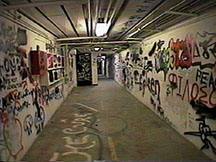 The real tunnel network — the naughty one — is the steam tunnel system.
The real tunnel network — the naughty one — is the steam tunnel system.
Steam tunnels are poorly lit, dirty, cramped, dangerous and uncomfortably hot. The bad news is they are strictly off-limits. Generally, school administration will manage to outlaw their use without ever admitting to their existence. Students caught in the tunnels are threatened with expulsion and non-students are threatened with serious fines. In spite of this, in colleges and universities across North America it has long been a popular student pastime to descend into the tunnel network and explore. Also known as "Utility Tunnels" or "Engineering Tunnels," the tunnels are most commonly referred to as steam tunnels because their primary function is to transport extremely high-temperature steam from a central boiler to all the buildings of the campus. The tunnels also conduct cold air, electrical wires, telephone lines, network connections and natural gas.
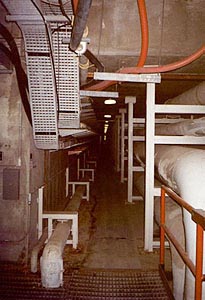 The atmosphere and appearance of tunnel networks varies greatly from school to school, but generally the main tunnels are not more than six feet wide by six feet tall. Some tunnel systems are well-lit and easy to navigate, while others are impossible mazes kept in complete darkness. The tunnels vary from completely clean and comfortable to extremely dusty and almost unbearably hot. The tunnels under York are taller and narrower than most, and vary from well-lit and comfy to pitch black and extremely hot.
The atmosphere and appearance of tunnel networks varies greatly from school to school, but generally the main tunnels are not more than six feet wide by six feet tall. Some tunnel systems are well-lit and easy to navigate, while others are impossible mazes kept in complete darkness. The tunnels vary from completely clean and comfortable to extremely dusty and almost unbearably hot. The tunnels under York are taller and narrower than most, and vary from well-lit and comfy to pitch black and extremely hot.
There are several different methods of entering the steam tunnels at York, but the safest and most reliable entrance can be found in the pedestrian tunnels near the main block of colleges (Vanier, Founders, Winters and McLaughlin). Look for a large brown metal door with healthy amounts of graffiti covering it — the graffiti in these tunnels changes from week to week, but as of May 3/97 the door was marked with a blue and silver pattern. In any case, you should be able to find the door if you just listen for the sound of heavy machinery on the other side. The door isn't locked, but it is very firmly wedged shut, so collect your strength, yell "Tentanda Via," and body slam the door with all your might. The door will crack open with an ungodly amount of noise and you'll stumble through into the fairly comfortable and well-lit tunnels under the colleges. This is another reason why the Vanier entrance is a good one — this is probably the safest and easiest to navigate part of the tunnels.
 On my first trip to the tunnels, during which Pablo acted as my tour guide, I was absolutely amazed to discover this hidden world on the other side of a non-descript door. At this point in the network, which some past scribe had dubbed the "Sasquatch Tunnels" for reasons unknown, the tunnels are about five feet wide by eight feet tall and not unbearably hot. The whirring and clacking of machinery is constant, and is often accompanied by the steady hiss of steam. This section of the tunnels is well-lit by steam tunnel standards, but quite dim in comparison to the pedestrian tunnels. The floor, walls and roof are all constructed out of cement, though occasionally the cement floor disappears and one walks on metal grates running over top of clusters of wiring or pools of water, or both. Pipes and wires galore run along both walls and occasionally hang from the ceiling as well. Most of the pipes are well insulated; be sure to stay away from any non-insulated pipes unless you happen to have a fondness for third-degree burns.
On my first trip to the tunnels, during which Pablo acted as my tour guide, I was absolutely amazed to discover this hidden world on the other side of a non-descript door. At this point in the network, which some past scribe had dubbed the "Sasquatch Tunnels" for reasons unknown, the tunnels are about five feet wide by eight feet tall and not unbearably hot. The whirring and clacking of machinery is constant, and is often accompanied by the steady hiss of steam. This section of the tunnels is well-lit by steam tunnel standards, but quite dim in comparison to the pedestrian tunnels. The floor, walls and roof are all constructed out of cement, though occasionally the cement floor disappears and one walks on metal grates running over top of clusters of wiring or pools of water, or both. Pipes and wires galore run along both walls and occasionally hang from the ceiling as well. Most of the pipes are well insulated; be sure to stay away from any non-insulated pipes unless you happen to have a fondness for third-degree burns.
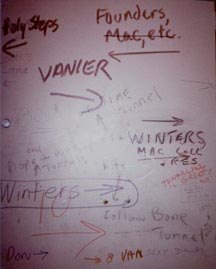 After a brief wander, we came to a four-way junction in the tunnels ("The Crossroads") with the option to turn off towards other colleges. Tunnelers from years past had helpfully graffitied this whole area with directions and advice, all of which we found quite reliable. Many of the instructions on this panel and in other locations throughout the tunnels seemed to have been left by some Dungeons & Dragons veteran, as the placenames required an extremely vivid imagination to understand and some of the instructions were mildly cryptic. Without any real system to our travels, we picked whatever tunnel looked most interesting and followed it to see what we could see. I won't even try to recommend an "order" in which you should examine the tunnels. The tunnels all look extremely similar, and there are very few landmarks to help you determine whether or not you've been somewhere before. Being in an unvariable, hot, underground environment for an extended period of time takes its toll on one's sense of direction. Pablo and I were lost several times, and confused most of the time. The map in the centre of Infiltration 4 may be a help, and it would probably also be smart to take along a little chalk so you can mark the cement walls. A compass might also be useful, if you have one handy.
After a brief wander, we came to a four-way junction in the tunnels ("The Crossroads") with the option to turn off towards other colleges. Tunnelers from years past had helpfully graffitied this whole area with directions and advice, all of which we found quite reliable. Many of the instructions on this panel and in other locations throughout the tunnels seemed to have been left by some Dungeons & Dragons veteran, as the placenames required an extremely vivid imagination to understand and some of the instructions were mildly cryptic. Without any real system to our travels, we picked whatever tunnel looked most interesting and followed it to see what we could see. I won't even try to recommend an "order" in which you should examine the tunnels. The tunnels all look extremely similar, and there are very few landmarks to help you determine whether or not you've been somewhere before. Being in an unvariable, hot, underground environment for an extended period of time takes its toll on one's sense of direction. Pablo and I were lost several times, and confused most of the time. The map in the centre of Infiltration 4 may be a help, and it would probably also be smart to take along a little chalk so you can mark the cement walls. A compass might also be useful, if you have one handy.
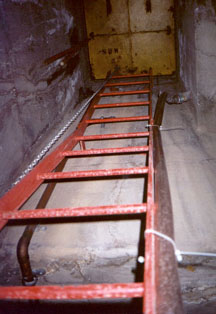 As Pablo and I traveled, we were quick to notice the tall red ladders which ascended back to the surface every fifty feet or so. A warning sign at the base of each ladder explained that these were emergency escape hatches and that there was a serious penalty for their misuse. On the night we explored the tunnels it was raining heavily so we could determine that most of these escape hatches opened to the outside. These would make a perfect getaway if security guards or physical plant personnel were ever chasing one, as long as one didn't pop out of the ground at the wrong location. We really weren't sure if all the physical plant staff had gone home for the day or not, so we were quite nervous for our first hour or so. On more than one occasion we were convinced we heard voices or footsteps and had to quickly decide whether it was more appropriate to run or hide. We had already decided beforehand that we wouldn't be giving ourselves up to the authorities, as Pablo wasn't very keen on the idea of being expelled.
As Pablo and I traveled, we were quick to notice the tall red ladders which ascended back to the surface every fifty feet or so. A warning sign at the base of each ladder explained that these were emergency escape hatches and that there was a serious penalty for their misuse. On the night we explored the tunnels it was raining heavily so we could determine that most of these escape hatches opened to the outside. These would make a perfect getaway if security guards or physical plant personnel were ever chasing one, as long as one didn't pop out of the ground at the wrong location. We really weren't sure if all the physical plant staff had gone home for the day or not, so we were quite nervous for our first hour or so. On more than one occasion we were convinced we heard voices or footsteps and had to quickly decide whether it was more appropriate to run or hide. We had already decided beforehand that we wouldn't be giving ourselves up to the authorities, as Pablo wasn't very keen on the idea of being expelled.
Some of the tunnels, particularly the unlit tunnels, seemed to go on forever. The tunnels are miles long, but I think the fact that they are so narrow and uniform makes them seem even longer. Pablo and I voyaged up one such never-ending tunnel in our quest to find the Physical Plant Building (also known in tunnel parlance as the CUB, or Central Utilities Building). The Physical Plant Building, which lies in the far eastern end of the campus away from all the colleges and lecture halls, is the capital of the tunnel system. This is the building where all the steam and cold air and love is generated and pumped out through the tunnels to the rest of the campus.
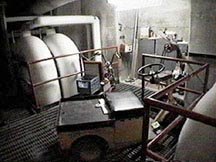 
The Physical Plant, at the heart of the tunnel system, was our ultimate goal, but also perhaps the most dangerous place in the system.
Only after we finally succeeded in reaching the Physical Plant Building did it occur to Pablo and I that it was also the homebase for all the employees who work in the tunnels. We snuck into one of the large engine rooms for a few quick pictures of some of the mammoth machinery. We also noticed recently extinguished cigarettes, half of someone's dinner, and several large buckets labeled "Sulphuric Acid", all of which indicated to us that the room probably wouldn't be empty for long. In spite of this, we scurried across the engine room floor to investigate a door on the opposite side. A window in the door revealed unlit tunnels stretching further east to who knows where, but the door was locked so we hurriedly returned to the (relative) safety of the main tunnel system and headed back to the west.
Upon returning to "The Crossroads", we decided to check out the areas the imaginative scribe had dubbed the "Ice Caves" and the "Tar Pits", to be found in the tunnels under Winters College and McLaughlin College. We hoped these underground tourist traps would be a little more interesting than Founders College's "Lover's Lane and the Holy Steps", which was the name our guide had donned upon a plain cement hallway with four cement steps. We found the tunnels leading to Winters to be smaller than most of the tunnels, perhaps six feet tall by four feet wide. Almost all the tunnels in this area were kept in complete darkness. In some cases these tunnels had overhead lights which were turned off, but in other areas there appeared to be no overhead lighting whatsoever. We were armed with weak little flashlights but these did not provide anywhere near enough light for us to see where we were going or how much further the tunnel stretched ahead. Descending ladders and stairs into the darkness is a real challenge. Tunneling can be quite nerve-wracking, but the psychological stimulation is really what makes it so attractive. You're constantly travelling further and further into the forbidden and the unknown.
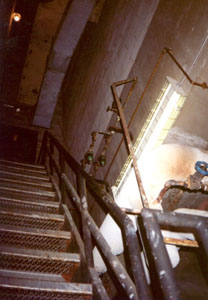 In our quest to become better acquainted with the unknown, we crouched down a little and navigated our way through the darkness to the Winters College tunnels, home of the heavily-advertised "Ice Caves." We were mildly disappointed when we discovered that the "Ice Caves" consisted of one cooling vent, which pumped some coolish air into one of the tunnels. Actually the air was probably just lukewarm and only seemed cool in comparison to the sweltering heat of most of the tunnels in this area. By this time we'd been down in the tunnels for over an hour and we were beginning to realize that the tunnels simply weren't designed for the average person to use. The lack of oxygen and the nearly unbearable heat can make one quite lightheaded — I felt faint on several occasions after climbing a ladder or some stairs. Further, the tunnels are filled with protruding high voltage wires, scalding pipes, low overhangs and other hazards. Somewhere around here I hit my head on a low-hanging pipe and felt a little dizzy for the rest of the trip.
In our quest to become better acquainted with the unknown, we crouched down a little and navigated our way through the darkness to the Winters College tunnels, home of the heavily-advertised "Ice Caves." We were mildly disappointed when we discovered that the "Ice Caves" consisted of one cooling vent, which pumped some coolish air into one of the tunnels. Actually the air was probably just lukewarm and only seemed cool in comparison to the sweltering heat of most of the tunnels in this area. By this time we'd been down in the tunnels for over an hour and we were beginning to realize that the tunnels simply weren't designed for the average person to use. The lack of oxygen and the nearly unbearable heat can make one quite lightheaded — I felt faint on several occasions after climbing a ladder or some stairs. Further, the tunnels are filled with protruding high voltage wires, scalding pipes, low overhangs and other hazards. Somewhere around here I hit my head on a low-hanging pipe and felt a little dizzy for the rest of the trip.
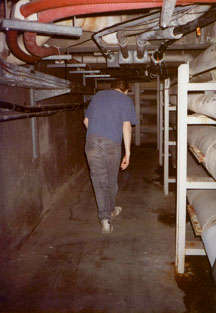 Of course, I couldn't even contemplate the idea of cutting the journey short, as the near-legendary "Tar Pits" of McLaughlin College beckoned. As we left the Winters tunnels and emerged into the McLaughlin tunnels we were relieved to finally stand upright once again — the McLaughlin tunnels are at least 12 feet tall and six feet wide, the largest tunnels in the network. We soon came to a junction where we had to choose between a lit tunnel and an unlit tunnel, and we chose to explore the unlit tunnel first. Before long we discovered a darkened mechanical room with a lit room next door. We thought we heard voices next door and assumed that it was staffed, so we were investigating the mechanical room in complete silence when I happened to accidentally slam into something loud and metallic. We escaped back into the dark tunnel just as we thought we heard an employee enter the mechanical room behind us. Without words, we decided to keep the flashlights off and travel up the unlit tunnel as fast as we thought we could. We figured that unless our pursuers happened to have a flashlight handy they couldn't possibly follow us into the tunnels. We weren't pursued.
Of course, I couldn't even contemplate the idea of cutting the journey short, as the near-legendary "Tar Pits" of McLaughlin College beckoned. As we left the Winters tunnels and emerged into the McLaughlin tunnels we were relieved to finally stand upright once again — the McLaughlin tunnels are at least 12 feet tall and six feet wide, the largest tunnels in the network. We soon came to a junction where we had to choose between a lit tunnel and an unlit tunnel, and we chose to explore the unlit tunnel first. Before long we discovered a darkened mechanical room with a lit room next door. We thought we heard voices next door and assumed that it was staffed, so we were investigating the mechanical room in complete silence when I happened to accidentally slam into something loud and metallic. We escaped back into the dark tunnel just as we thought we heard an employee enter the mechanical room behind us. Without words, we decided to keep the flashlights off and travel up the unlit tunnel as fast as we thought we could. We figured that unless our pursuers happened to have a flashlight handy they couldn't possibly follow us into the tunnels. We weren't pursued.
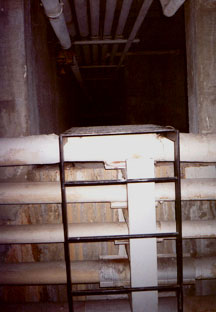 On our way back, we turned off into McLaughlin's lit tunnel in search of the tourist attraction that put the McLaughlin tunnels on the map. It didn't take very long before we stumbled upon the "Tar Pits": some pools of dirty water in the floor of the main hallway. Shortly after tearing ourselves away from this spectacle, we stumbled upon an attraction which we were pretty sure was something special. Halfway up the wall of one of the main tunnels was a tiny little 3x3-pipe shaft, which seemed to stretch on for some distance. We climbed up and in, and after some debate decided to crawl through the extremely dusty, unlit tunnel and see what treasures it held. After about five minutes the tunnel turned 90 degrees to the right, we continued crawling. After another 15 minutes the tunnel again turned 90 degrees to the right, we continued crawling. After a further five minutes of crawling, we descended a ladder back into the main tunnel, 20 feet further along from the point where we had originally entered the pipe shaft. As we left McLaughlin College, filthy and exhausted, and we decided that this part of our journey should not be considered an exploratory triumph.
On our way back, we turned off into McLaughlin's lit tunnel in search of the tourist attraction that put the McLaughlin tunnels on the map. It didn't take very long before we stumbled upon the "Tar Pits": some pools of dirty water in the floor of the main hallway. Shortly after tearing ourselves away from this spectacle, we stumbled upon an attraction which we were pretty sure was something special. Halfway up the wall of one of the main tunnels was a tiny little 3x3-pipe shaft, which seemed to stretch on for some distance. We climbed up and in, and after some debate decided to crawl through the extremely dusty, unlit tunnel and see what treasures it held. After about five minutes the tunnel turned 90 degrees to the right, we continued crawling. After another 15 minutes the tunnel again turned 90 degrees to the right, we continued crawling. After a further five minutes of crawling, we descended a ladder back into the main tunnel, 20 feet further along from the point where we had originally entered the pipe shaft. As we left McLaughlin College, filthy and exhausted, and we decided that this part of our journey should not be considered an exploratory triumph.
Upon returning to "The Crossroads," we decided to investigate the final fork of the tunnel system, the one which headed off towards the far west end of campus, where we were promised the glories of the "Rat Tunnels," "Down Under" and an extremely tempting site known as "Echo Valley." This was a very long walk, broken up only by the clever (and not-so-clever) graffiti of explorers past. We found graffiti dating back to 1979, when someone had spray painted "The Clash" at the end of the main tunnel. We also found a few dozen mechanical rooms connected to the tunnels at various points, often at the top of flights of stairs. These were all unlocked.
 Most of the tunnel heading west towards the Stong and Bethune tunnels was pitch black and quite wet. As I mentioned previously, it was raining very heavily during our excursion, so many areas were slightly flooded. We were just glad to get an occasional cool shower whenever we wandered underneath one of the emergency escape hatches. In a few locations, deposits from dripping water had created small stalactites which hung from the cement ceiling, and which led me to wonder if the entire tunnel network would gradually become more and more like a natural cave over the centuries.
Most of the tunnel heading west towards the Stong and Bethune tunnels was pitch black and quite wet. As I mentioned previously, it was raining very heavily during our excursion, so many areas were slightly flooded. We were just glad to get an occasional cool shower whenever we wandered underneath one of the emergency escape hatches. In a few locations, deposits from dripping water had created small stalactites which hung from the cement ceiling, and which led me to wonder if the entire tunnel network would gradually become more and more like a natural cave over the centuries.
In any case, we were too thirsty to wait and see, as by this time we'd been tunnel running for almost two hours. As we wandered further and further to the west, we caught a whiff of chlorine up ahead and our poor heat-stroked minds danced with visions of swimming pools. Pablo reasoned that the area underneath the Tait Pool might possibly be a little cooler than the main tunnels, and I agreed, secretly hoping that perhaps there would be a leak in the roof and I could drink the cold, poisonous, refreshing pool water as it poured down. (Hours of nothing but walking and crawling in heat and dust can make one extremely desperate for drink. If the Physical Plant were to put a Coke machine down here somewhere I'm sure they could easily get away with charging $10 a can.) We followed our noses towards the scent of chlorine for some distance, and though the tunnels did indeed cool off, it was just another case of dirty floorwater everywhere and not a drop to drink. We concluded that we would just grab a quick peek at the remaining tourist attractions and then call it a night.
Unfortunately, this area of the tunnels wasn't anywhere near as well traveled or as well-marked as the central and eastern tunnels, which made them more difficult to navigate. We never did find the "Rat Tunnels" or "Down Under," and only after considerable exploration did we manage to locate "Echo Valley": a plain cement tunnel in which someone once imagined that they had heard an echo. We tried to recreate the phenomenon but simply could not force the tunnel to echo, so we began the long journey back to freedom.
 We wearily followed the various signs directing us towards the "Sasquatch Tunnels" and "Home Sweet Home." When we finally re-emerged into the pedestrian tunnels, it was like entering a cool, oxygen-rich paradise. We ascended to the surface and quickly proceeded to drink heavily, wash the layers of dirt off our exhausted, sweaty bodies, and speculate about what lay down the tunnels we had not yet investigated.
We wearily followed the various signs directing us towards the "Sasquatch Tunnels" and "Home Sweet Home." When we finally re-emerged into the pedestrian tunnels, it was like entering a cool, oxygen-rich paradise. We ascended to the surface and quickly proceeded to drink heavily, wash the layers of dirt off our exhausted, sweaty bodies, and speculate about what lay down the tunnels we had not yet investigated.
This article originally appeared in Infiltration 4, together with other features related to college tunnels.
|

